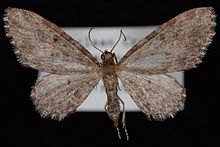Eupithecia lachrymosa is a moth in the family Geometridae first described by George Duryea Hulst in 1900.[1][2] It is found in North America from central Saskatchewan west to southern Vancouver Island, north to British Columbia and Alberta and south to California.[3]
| Eupithecia lachrymosa | |
|---|---|

| |
| Scientific classification | |
| Domain: | Eukaryota |
| Kingdom: | Animalia |
| Phylum: | Arthropoda |
| Class: | Insecta |
| Order: | Lepidoptera |
| Family: | Geometridae |
| Genus: | Eupithecia |
| Species: | E. lachrymosa
|
| Binomial name | |
| Eupithecia lachrymosa (Hulst, 1900)
| |
| Synonyms | |
| |
The wingspan is 19–24 mm.
The larvae feed on Betula papyrifera, Salix, Ceanothus, and Alnus species.[4]
References
editWikimedia Commons has media related to Eupithecia lachrymosa.
Wikispecies has information related to Eupithecia lachrymosa.
- ^ Yu, Dicky Sick Ki. "Eupithecia lachrymosa (Hulst 1900)". Home of Ichneumonoidea. Taxapad. Archived from the original on March 25, 2016.
- ^ "910386.00 – 7548 – Eupithecia lachrymosa – (Hulst, 1900)". North American Moth Photographers Group. Mississippi State University. Retrieved May 2, 2019.
- ^ Rindge, Frederick H. (July 25, 1963). "Notes on and descriptions of North American Eupithecia (Lepidoptera, Geometridae)" (PDF). American Museum Novitates (2147): 1–23.
- ^ Anweiler, G. G. (September 7, 2004). "Species Details: Eupithecia lachrymosa". University of Alberta Museums. E.H. Strickland Entomological Museum. Retrieved December 27, 2020.